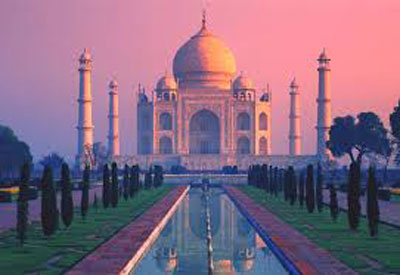 Agra:
Agra: As one of the world's most photographed monuments, the 17th century Taj Mahal continues to delight and fascinate camerapersons from all over the world.
Every day, hordes of photographers - both amateurs and professionals - shoot pictures of the white marble mausoleum, bringing joy and excitement to those who pose against its backdrop.
"For many, it's the fulfilment of a dream," tourist guide Ved Gautam says.
"It's the architecture, the perspective and the unique backdrop that includes the Yamuna and a whitish skyline that appears to extend to eternity that I find most appealing," "its the architecture, the perspective and the unique backdrop that includes the Yamuna and a whitish skyline that appears to extend to eternity, that I find most appealing," added Gautam, who has started a photography club.
For 90-year-old Ramesh Chandra Khandelwal Agra's oldest photographer and who runs the more than a century old firm of Priya Lal and Sons, the Taj Mahal will never lose its fascination and awe.
"One building with immaculate, Nayaab dimensions, perfect lighting conditions, such variety of angles and contrasts, what else could a photographer want? And if you take into account its history and the romanticism associated with it, who would not like to be photographed with it," he asked.
Wildlife photographer Lalit Rajora, who began his journey 16 years ago from the Taj Mahal, still can not delink himself with the grand Mughal monument.
"The grand Taj Mahal, with its enticing beauty, has an eternal fascination for me. Its aesthetic beauty, pristine craftsmenship and grandeur attracts me as a photograph does. As a photographer, when this attraction coverted into an unfading romance and passion is difficult to tell. All I can say is that the Taj, under the seasonal hues of the sky enkindles my soul, gives wings to my imagination and meaning to my expression and creativity," Rajoria declaimed.
Vijay Goyal, owner of the Speed Colour Lab, who spent 20-odd years at the Taj Mahal shooting pictures for tourists and VIPs, said: "I recall the statement of a lady tourist long back. She reacted: 'Oh my god, this looks much better than the photograph I saw back home'."
Goyal said the Taj Mahal faces south. "The sun rises from the east on the left and traverses the whole distance to the right (west) providing different contrasts, shades and colours - never a dull moment. Each angle is different, its symmetry and geometry is perfect and flawless. There is a mix of colours - red sand-stone justaposed with white marble and a profusion of green vegetation, while the shades of blue and white. Rare is a man-made structure in the world that provides such a spectacular variety and mind you, there is no artificial lighting anywhere as in the Eiffel Tower or many other monuments."
Vishal, a photographer and owner of the Nice Studio, one of Agra's oldest, said: "Every day, every hour, every season is different. The white marble mausoleum reflects nature's varied moods. People see romance and poetry in it. The beauty of the Taj Mahal lies in its totality, not in parts. The framed portrait - like the view from the main entrance - has been compared to a veiled bride. The mystery of the Taj's beauty will never be fully explained. The colours of Jannat have been used to weave intricate patterns and layouts, the fountains, the green shrubs, the natural skyline ...you look at it from any angle, it's a manifestation of beauty and no wonder many say it's a divine monument."
"Even the visitors in thousand coming daily are part of the Taj Mahal, adding colours and flavours of a cosmopolitan nature, as if the whole world is represented here in a miniscule, the tranquility and the awe that one feels gives it a special status. The Taj is a living and breathing monument, you can feel it," said 70-year old Surendra Sharma of the Fine Arts Studio.
"Now, of course with advanced technology and camera-fitted mobile phones, everyone is a photographer, but there was a time when with primitive cameras shooting in black and white, the real essence of photography was brought out and memorable pictures taken," Sharma addded.
 Agra: As one of the world's most photographed monuments, the 17th century Taj Mahal continues to delight and fascinate camerapersons from all over the world.
Agra: As one of the world's most photographed monuments, the 17th century Taj Mahal continues to delight and fascinate camerapersons from all over the world.